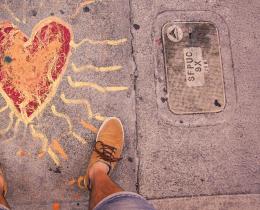For many of us, our computers, smartphones, and tablets have taken over our lives, inserting themselves into more and more places as they have replaced functions that used be done by multiple devices, or by time-tested analog technologies.
Taking notes, listening to music, watching TV shows or movies, reading books and newspapers, and even connecting with friends, are all increasingly done with the same device. Creative pursuits like photography and playing music are all now centered around a device for many.
There are certainly advantages to digitization and this interconnectivity. Photography is easier than ever, from a technical perspective, as is sharing our work with others. Through social media we can share our thoughts, feelings, and experiences with anyone we know, anywhere in the world, instantly.
But the sheer amount of time we spend gazing at a screen into a virtual world also can bring with it distraction and a disconnection from the places, people, and events immediately in front of us.
Former social media influencer Lee Tilghman understands that disconnection all too well. As founder of the wellness blog and Instagram, Lee From America, Lee was dubbed the “Smoothie Bowl Queen” by Free People’s BLDG25 and “wellness culture [itself]” by the New York Times. When Lee started to experience severe burnout from pumping out content around the clock, she began to reconsider how she was living.
"I got tired of posting aspiring content in a specific niche, having people envy my lifestyle, and shop my links accordingly," she says. "I now run a newsletter, Offline Time, that examines my former wellness influencer life and our exceedingly digital culture."
In extreme cases something approaching addiction can occur, Lee says, accompanied by anxiety, worry, and withdrawal symptoms when we’re forcibly disconnected. Throughout her career, Lee has spoken at SXSW, Project Liberty, Villanova University, and to members of Congress concerning tech safety and addiction.
By stepping out of this stream of constant information, you can more easily realize the connections, opportunities, and interactive possibilities that always exist all around you, Lee says.
You can also more easily step aside, sit down, and take a moment to pause, recenter yourself, witness your thoughts, refocus your attention, and refresh yourself. Then, when you reenter the stream you can do so on your own terms, and in a way that more sustainably works for you.
Ways to Take a Break From Your Digital Life
- Wait to check your email until a certain time of the day and/or check it only at certain times of the day.
- Don't read the news until a set time of the day and then only using a certain few trusted sources, rather than following every twist and turn the news cycle takes.
- Limit your time on social media to a set period a day and for a limited time.
- Choose a day each week, or a weekend each month, when you don’t use email, read the news, or check social media.
- Establish a regular time for a couple of days each month, quarter, or year where you unplug from your digital devices entirely. This unplugging can be enhanced by spending some time in nature. The affects on improving your mental clarity can be profound, as a study undertaken by five neuroscientists rafting in an off-grid area of Utah shows.
- If you’re taking a full day off from digital media, consider turning off your WiFi network and/or fulling unplugging your internet connection from the wall. It’s a hassle, but that’s the point; it will take another level of effort to plug back in, perhaps enough to keep you from doing so for whatever time period you’ve decided to disconnect yourself.
How to Cut Down Device Use When You Are Plugged In
- If you normally use your phone as an alarm clock, buy a dedicated alarm clock and leave your smartphone charging in another room. This won’t prevent you from simply getting out of bed and checking your phone, but it does provide an additional moment to pause before doing so.
- For email on your phone: Set the mail application so that it only checks email when you tell it to, not automatically. To do this turn off push notifications on you device. On your iOS device, you can do this by going to Settings→Mail, Contacts, Calendars→Fetch New Data and sliding the Push button off. If you have an Android device, this short video explains how you can turn off notifications.
- For email on your computer: If you can’t set the interval when your email application checks for new messages, then turn off the application when you're not using it. If your operating system sends notifications for new social media messages, turn these off as well.
- Turn off push notifications from all your social media apps to stop instant notification that you have received a message. As with email notifications this can be done in the Settings app on your device.



